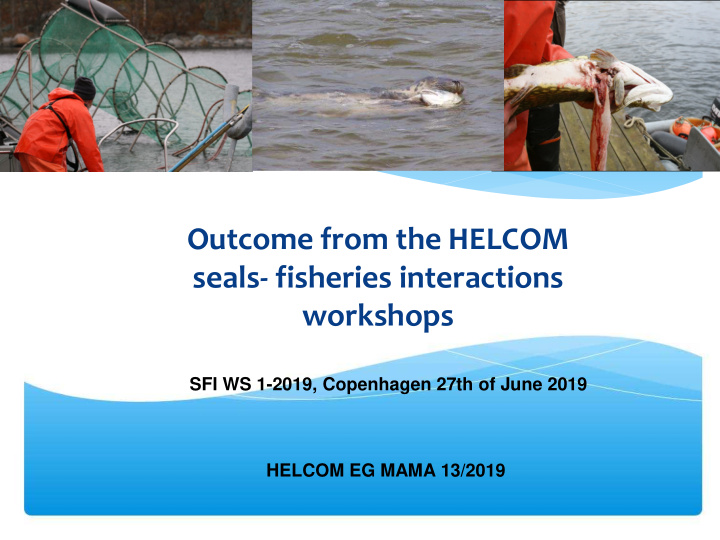



Outcome from the HELCOM seals- fisheries interactions workshops SFI WS 1-2019, Copenhagen 27th of June 2019 HELCOM EG MAMA 13/2019
HELCOM SEAL RECOMMENDATION 27-28/21: CONSERVATION OF SEALS IN THE BALTIC SEA AREA, thresholds for GES integrated assessment, and monitoring of Baltic seals, 2
Seals and fisheries interactions in Sweden
Status of Grey Seals in German Baltic waters with implications for management 4
Baltic Sea Seal & Cormorant TNC 5
Outcome of the BALTFISH symposium on interactions between seals, fish and fisheries in the Baltic Sea 19-20 of March, Gothenburg Main themes: Seal and fish in the Baltic Sea HELCOM recommendation 27-28/21 Seal and fish interaction in the Baltic Sea Seal-fish parasites BSAC Public awareness and how the increasing seal population affects the coastal society Economic implications of increasing seal population in the fisheries Seal safe gears
Right questions to ask and difficult choices to be made The fishery problem The biodiversity problem The ecosystem problem What is it that managers really want to achieve? 7
Division into subgroups ∗ 4 subgroups (8-9 people each) Formulated under one expert for each subgroup: ∗ Anders Galatius; ∗ Mart Jüssi; ∗ Sven Gunnar Lunneryd; ∗ Nils Höglund Two groups dealing with solutions to mitigate seals-fisheries interactions; Two groups dealing with questions regarding population status of seals in the Baltic Sea; All groups dealing with next steps and proposals concerning update of the HELCOM Baltic Sea Action Plan. 8
Fisheries Mirosław Daniluk, Polish fisherman 9
Discussion on possible solutions ∗ Seal safe gears: ∗ Non-lethal mitigation: Compensation systems Limiting protection measures Iwona Psuty, NFMRI Benefits from having seals Mirosław Daniluk, Polish fisherman ∗ Hunting and culling: Background document: Protocol for the scientific evaluation of proposals to cull marine mammals. 10
Biodiversity/seal populations Katarzyna Stepanowska, ZUT, Poland 11
Discussion on the remaining questions concerning populations of seals in the Baltic Sea ∗ Seal population status – do we have enough knowledge? ∗ What do you think about set reference points in HELCOM Rec. 27-28/2 on conservation of seals? ∗ Knowing the different status of seals in different BS regions should they be managed in subregions? ∗ Would a cull can cause that seals will move to another areas? ∗ Can by-catch pose a treat to populations’ status of seals? Background document also to be used: English translation of a Soviet study on infection of the liver of Baltic cod with roundworms 12
Outcome from the discussions GROUP 1 ∗ HELCOM Recommendation 27-28/2 serves its role including Limit Reference Precautionary Approach and Target Reference Level; ∗ More data on seal parasites are needed and integration of data on an ecosystem basis is also lacking; ∗ Seal distribution monitoring is limited in scope, meaning that it is not possible to assess the impact of management actions for several years. 13
Outcome from the discussions GROUP 2 ∗ More knowledge on seal movements year round; ∗ An international telemetry study could assess the monitoring results and population status more adequately; ∗ Workshops such as this are useful in kicking off discussions and involving various stakeholders, but more regular meetings would be needed in order to make progress in addressing the issue.
Outcome from the discussions GROUP 3 ∗ Little is known about the relationship between seal abundance and parasite prevalence in fish; ∗ Complete post mortem investigations on fish (histology, parasitology, toxicology, chemical biomarkers); parallel parasitological survey on seals and fish in certain areas) is needed; ∗ With regard to hunting and culling there is the need for a wider biodiversity view about protection, recognizing also the protection success story of increasing seal populations 15
Outcome from the discussions ∗ GROUP 4 ∗ Better knowledge on the food web dynamics, the links between open sea and coastal fish stocks and potential implications for seal foraging behaviour and distribution are needed; ∗ Need for setting aside a part of EMFF funding specifically for gear development and cooperation (although outside the remit of HELCOM); ∗ Need to involve relevant HELCOM groups into cooperation; ∗ Deeper involvement of fishermen directly into the gear development, new structures are potentially needed to help innovation. Culling is costly, but on a local scale it could be an option, although debatable. 16
Final conclusions Abundance data is available, but spatial and temporal distribution of seals at sea is not as well known. Involvement from all stakeholders would be needed, including fishermen and nature conservation stakeholders. The issue of how to tackle the interactions between seals and fisheries may need to be divided into tangible portions (e.g. ecology, fisheries management, depredation and technical options) and to involve the relevant experts to consider each portion. The Workshop was seen as a useful start to the discussions in addressing seal-fisheries interactions in the Baltic Sea, but more work, including involvement of, e.g. the HELCOM Fish Group, State & Conservation, EG MAMA, EN-Noise, the HELCOM-VASAB Working Group on MSP is evident, including the process of 17 updating Baltic Sea Action Plan.
Thank you Polish conference on seals- 18 fisheries interactions June 2017
Recommend
More recommend